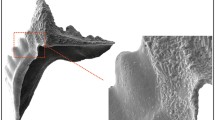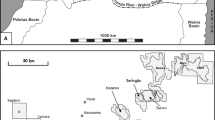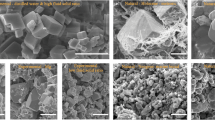Abstract
Conodonts from the middle to upper Paleozoic limestones of the Cantabrian zone commonly show apatite overgrowths. A large crystal microtexture observed under the SEM corresponds to local rims of euhedral to subhedral apatite crystals, which were preceded by the neoformation of smaller crystals. Four types of this microtexture (blocky, columnar, fan, and denticular) are described on different areas of the oral surface of conodonts, whereas dissolution features may be present in the basal cavity area. The distribution of these types of microtexture in different areas of conodont morphology suggests a general trend to neocrystallization, where crystal size increases towards the top of the conodont ornamentation and a chemical gradient controls the crystalline growth. This arrangement is widely related to the surface morphology and to the general conodont histology. The large crystal microtexture grows during early diagenesis from near surface to moderate burial and is linked to the known secondary apatite cement present in natural fused clusters of conodonts. The features described here are also compared to microtextures developed on conodonts during low- to medium-grade metamorphic conditions, where phosphate in solution is available.









Similar content being viewed by others
References
Allison PA (1988) Phosphatized soft-bodied squids from the Jurassic Oxford Clay. Lethaia 21:403–410
Austin RL, Burnett RD (1994) Preliminary Carboniferous conodont CAI data South Wales, the Mendips and ajacent areas, United Kingdom. Mem Inst Géol Univ Cathol Louvain 35:137–153
Barnes CR, Sass DB, Poplawski MLS (1973) Conodont ultrastructure: the Family Panderodontidae. R Ont Mus Life Sci Contrib 90:1–35
Baturin GN (2002) Nodular fraction of phosphate sand from the Namibia shelf. Lith Miner Resour 37:1–17
Benmore RA, Coleman ML, McArthur JM (1983) Origin of sedimentary francolite from its sulphur and carbon isotope composition. Nature 302:516–518
Blanco-Ferrera S (2011) Los conodontos y la evolución tectonotérmica del sector noreste de la Zona Cantábrica. Dissertation, University of Oviedo
Blanco-Ferrera S, Sanz-López J, García-López S, Bastida F, Valín ML (2011) Conodont alteration and tectonothermal evolution of a diagenetic unit in the Iberian Variscan belt (Ponga-Cuera unit, NW Spain). Geol Mag 148:35–49. doi:10.1017/S0016756810000269
Bouch JE, Hole MJ, Trewin NH, Morton AC (1995) Low-temperature aqueous mobility of the rare-earth elements during sandstone diagenesis. J Geol Soc Lond 152:895–898
Burnett RD (1988) Physical and chemical changes in conodonts from contact-metamorphosed limestones. Ir J Earth Sci 9:79–119
Burnett RD, Hall JC (1992) Significance of ultrastructural features in etched conodonts. J Paleontol 66:266–276
Colmenero JR, Suárez-Ruiz I, Fernández-Suárez J, Barba P, Llorens T (2008) Genesis and rank distribution of Upper Carboniferous coal basins in the Cantabrian Mountains, Northern Spain. Int J Coal Geol 76:187–204. doi:10.1016/j.coal.2008.08.004
Donoghue PCJ (1998) Growth and patterning in the conodont skeleton. Phil Trans R Soc Lond B 353:633–666
Donoghue PCJ (2001) Microstructural variation in conodont enamel is a functional adaptation. Proc R Soc Lond B 268:1691–1698. doi:10.1098/rspb.2001.1728
Ebneth S, Diener A, Buhl D, Veizer J (1997) Strontium isotope systematics of conodonts: Middle Devonian, Eifel Mountains, Germany. Palaeogeogr Palaeoclimatol Palaeoecol 132:79–96
Epstein AG, Epstein JB, Harris LD (1977) Conodont colour alteration—an index to organic metamorphism. US Geol Surv Prof Pap 995:1–27
Föllmi KB (1996) The phosphorus cycle, phosphogenesis and marine phosphate-rich deposits. Earth Sci Rev 40:55–124
García-López S, Bastida F, Brime C, Aller J, Valín ML, Sanz-López J, Méndez CA, Menéndez-Álvarez JR (1999) Los episodios metamórficos de la Zona Cantábrica y su contexto estructural. Trab Geol Univ Oviedo 21:177–187
García-López S, Bastida F, Aller JA, Sanz-López J (2001) Geothermal paleogradients and metamorphic zonation from the conodont colour alteration index (CAI). Terra Nova 13:79–83
García-López S, Blanco-Ferrera S, Sanz-López J (2006) Aplicación de los conodontos al conocimiento de la evolución tectonotérmica de las zonas externas de los orógenos. Rev Esp Micropaleontol 38:289–297
García-López S, Brime C, Valín ML, Sanz-López J, Bastida F, Aller J, Blanco-Ferrera S (2007) Tectonothermal evolution of a foreland fold and thrust belt: the Cantabrian Zone (Iberian Variscan belt, NW Spain). Terra Nova 19:469–475. doi:10.1111/j.1365-3121.2077.00773.x
Gross W (1960) Über die Basis bei den Gattungen Palmatolepis und Polygnathus (Conodontida). Paläontol Z 34:40–58
Guidry MW, MacKenzie F (2003) Experimental study of igneous and sedimentary apatite dissolution: control of pH, distance from equilibrium, and temperature on dissolution rates. Geochim Cosmochim Acta 67:2949–2963. doi:10.1016/S0016-7037(03)00265-5
Gulbrandsen RA (1969) Physical and chemical factor in the formation of marine apatite. Econ Geol 64:365–382
Hass WH, Lindberg ML (1946) Orientation of the crystal units in conodonts. J Paleontol 20:501–504
Helsen S (1994) Micromorphological changes in Pridolian-Lochkovian conodonts from low grade metamorphosed Naux Limestone (Ardennes, France). Bull Soc Belg Géol 103:205–217
Helsen S (1995) Conodont alteration in Devono-Carboniferous dolomites from southern Belgium. Geol Mijnb 74:225–234
Jarvis I, Burnett WC, Nathan Y, Almbaydin FSM, Attia AKM, Castro LN, Flicoteaux R, Hilmy ME, Husain V, Qutawnah AA, Serjani A, Zanin YN (1994) Phosphorite geochemistry: state-of-the-art and environmental concerns. Eclogae Geol Helv 87(3):643–700
Jones B, Renaut RW (1995) Noncrystallographic calcite dendrites from hot-spring deposits at Lake Bogoria, Kenya. J Sediment Res A65:154–169
Königshof P (2003) Conodont deformation patterns and textural alteration in Paleozoic conodonts: examples from Germany and France. Palaeodivers Palaeoenviron 83:149–156
Krajewski KP (1984) Early diagenetic phosphate cements in the Albian condensed glauconitic limestone of the Tatra Mountains, Western Carpathians. Sedimentol 31:443–470. doi:10.1111/j.1365-3901.1984.tb01812.x
Krajewski KP (2000) Diagenetic recrystallization and neoformation of apatite in the Triassic phosphogenic facies in Svalbard. Stud Geol Pol 116:111–137
Krajewski KP, Van Cappellen P, Trichet J, Kuhn O, Lucas J, Martín-Algarra A, Prévot L, Tewari VC, Gaspar L, Knight RI, Lamboy M (1994) Biological processes and apatite formation in sedimentary environments. Eclogae Geol Helv 87(3):701–745
Lindström M (1955) Conodonts from the lowermost Ordovician strata of south-central Sweden. Geol Foren Stockh Forh 76:517–604
Lofgren G (1974) An experimental study of plagioclase crystal morphology: isothermal crystallization. Am J Sci 274:243–273
Maas A, Braun A, Dong X-P, Donoghue PCJ, Müller KJ, Olempska E, Repetski JE, Siveter DJ, Stein M, Waloszek D (2006) The ‘Orsten’-more than a Cambrian Konservat-Lagerstätte yielding exceptional preservation. Paleoworld 15:266–282
Mirăută E (1974) Über die Conodontenfaunen des oberen Werfens und des tieferen Anis der nördlichen Dobrudscha/Rumänien. Geol Palaeontol 8:149–158
Müller KJ, Nogami Y (1971) Über den Feinbau der Conodonten. Mem Fac Sci Kyoto Univ Ser Geol Min 38:1–87
Nicoll RS (1982) Multielement composition of the conodont Icriodus expansus Branson & Mehl from the Upper Devonian of the Canning Basin, Western Australia. BMR J Aust Geol Geophys 7:197–213
Nicoll RS (1985) Multielement composition of the conodont species Polygnathus xylus xylus Stauffer, 1940 and Ozarkodina brevis (Bischoff & Ziegler, 1957) from the Upper Devonian of the Canning Basin, Western Australia. BMR J Aust Geol Geophys 9:133–147
Nicoll RS, Rexroad CB (1987) Re-examination of Silurian conodont clusters from northern Indiana. In: Aldridge RJ (ed) Palaeobiology of conodonts. British Micropalaeontological Society Series. Ellis Horwood, Chichester, pp 49–61
Nöth S (1998) Conodont color (CAI) versus microcrystalline and textural changes in Upper Triassic conodonts from Northwest Germany. Facies 38:165–174
Okazaki M (1993) Crystallographic morphology of heterogeneous fluoridated carbonate apatites. J Dent Res 72:1285–1290
Pander CH (1856) Monographie der fossilen Fische des Silurischen Systems der russisch-baltischen Gouvernements. Akademie der Wissenschaften, St. Petersburg
Pierce RW, Langenheim RL Jr (1970) Surface patterns on selected Mississippian conodonts. Geol Soc Am Bull 81:3225–3236
Pietzner H, Vahl J, Werner H, Ziegler W (1968) Zur chemischen zusammensetzung und mikromorphologie der conodonten. Palaeontogr A 128:115–152
Pollock CA (1969) Fused Silurian conodont clusters from Indiana. J Paleontol 43:929–935
Prévôt L, Lucas J (1984) Apatite synthesis by bacterial activity from phosphatic organic matter and several calcium carbonates in natural freshwater and seawater. Chem Geol 42:101–118
Prévôt L, Lucas J (1990) Phosphate. In: Briggs DE, Crowther PR (eds) Palaeobiology, a synthesis. Blackwell, Cambridge, pp 256–257
Pucéat E, Reynard B, Lécuyer C (2004) Can crystallinity be used to determine the degree of chemical alteration of biogenic apatites? Chem Geol 205:83–97. doi:10.1016/j.chemgeo.2003.12.014
Rasmussen B (1996) Early-diagenetic REE-phosphate minerals (florencite, gorceixite, crandallite, and xenotime) in marine sandstones: a major sink for oceanic phosphorus. Am J Sci 296:601–632
Rejebian VA, Harris AG, Huebner JS (1987) Conodont colour and textural alteration: An index to regional metamorphism and hydrothermal alteration. Geol Soc Am Bull 99:471–479
Rexroad CB, Nicoll RS (1964) A Silurian conodont with tetanus? J Paleontol 38:771–773
Roussel EG, Cambon Bonavita M-A, Querellou J, Cragg BA, Webster G, Prieur D, Parkes RJ (2008) Extending the sub-sea-floor biosphere. Science 320:1046. doi:10.1126/science.1154545
Sagemann J, Bale SJ, Briggs DEG, Parkes RJ (1999) Controls on the formation of authigenic minerals in association with decaying organic matter: An experimental approach. Geochim Cosmochim Acta 63:1083–1095
Sanz-López J, Blanco-Ferrera S, García-López S (2009) Changes of the apatite overgrowth on the surface of diacaizonal conodonts from the Cantabrian Zone (Spain). Permophiles 53(Suppl 1):46
Schulz HN, Schulz HD (2005) Large sulfur bacteria and the formation of phosphorite. Science 307:416–418
Stauffer C, Plummer HJ (1932) Texas Pennsylvanian conodonts and their stratigraphic relations. Tex Univ Bull 3201:13–50
Suess E (1979) Phosphate regeneration from sediments of the Peru continental margin by dissolution of fish debris. Geochim Cosmochim Acta 45:577–588
Tribovillard N, Récourt P, Trentesaux A (2010) Bacterial calcification as a possible trigger for francolite precipitation under sulfidic conditions. CR Geosci 342:27–35
Trotter JA, Eggins SM (2006) Chemical analysis of conodont apatite determined by laser ablation ICPMS. Chem Geol 233:196–216. doi:10.1016/j.chemgeo.2006.03.004
Trotter JA, Fitz Gerald JD, Kokkonen H, Barnes CR (2007) New insights into the ultrastructure, permeability, and integrity of conodont apatite determined by transmission electron microscopy. Lethaia 40:97–110. doi:10.1111/j.1502-3931.2007.00024.x
Turner G, Morton AC (2007) The effects of burial diagenesis on detrital heavy minerals grain surface textures. In: Mange MA, Wright DT (eds) Heavy minerals in use. Developments in sedimentology, vol 58. Elsevier, Amsterdam, pp 393–412
Viswanath B, Ravishankar N (2008) Controlled synthesis on plate-shaped hydroxyapatite and implications for the morphology of the apatite phase in bone. Biomaterials 29:4855–4863. doi:10.1016/j.biomaterials.2008.09.001
von Bitter PH, Austin RL (1984) The Dinantian Taphrognathus transatlanticus conodont range Zone of Great Britain and Atlantic Canada. Palaeontol 27:96–111
von Bitter PH, Plint-Geberl HA (1982) Conodont biostratigraphy of the Codroy Group (Lower Carboniferous), southwestern Newfoundland, Canada. Can J Earth Sci 19:193–221
von Bitter PH, Purnell MA (2005) An experimental investigation of post-depositional taphonomic bias in conodonts. Spec Pap Palaeontol 73:39–56
Zhuralev AV (2002) A new type of conodont hard tissue. Lethaia 35:275–276
Acknowledgments
This work was finished during a PhD thesis completed by SBF at the University of Oviedo. It has been supported by Spanish project CGL-2009-09109 funded by the ‘Ministerio de Ciencia e Innovación’ and ‘Fondo Europeo de Desarrollo Regional’ (FEDER).The authors would like to express their gratitude to Ada Castro, Catalina Sueiro and Belén López (Research Support Services, University of A Coruña) for their assistance with the scanning electron microscope, and John Hardwick for his comments and suggestions in the language review. We are extremely grateful to Maurice E. Tucker (main-Editor of FACIES) and to referee Graciela N. Sarmiento for useful comments on the manuscript.
Author information
Authors and Affiliations
Corresponding author
Rights and permissions
About this article
Cite this article
Sanz-López, J., Blanco-Ferrera, S. Overgrowths of large authigenic apatite crystals on the surface of conodonts from Cantabrian limestones (Spain). Facies 58, 707–726 (2012). https://doi.org/10.1007/s10347-012-0295-3
Received:
Accepted:
Published:
Issue Date:
DOI: https://doi.org/10.1007/s10347-012-0295-3




